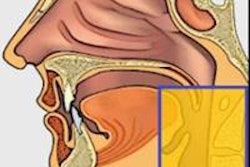
Radiologists are increasingly utilizing mobile devices in clinical applications, paving the way for new opportunities for image sharing and improved communication with clinicians and even patients, according to the results of a new Europe-wide survey presented at last month's ECR 2014 in Vienna.
Mobile devices are not currently suited for primary diagnostic image interpretation, and their use in radiology applications requires awareness of their advantages and disadvantages, as well as implementing appropriate IT infrastructure and policies to ensure security. But the ability of these devices as a means to share images and communicate will be transformative, noted Dr. Erik Ranschaert, a radiologist from Jeroen Bosch Ziekenhuis in the Netherlands.
"I'm convinced that these mobile devices are creating a shift toward easier image sharing and communication with others, not only with other colleagues but also with patients," he said. "Therefore, they are likely to reshape radiology and medicine."
Growing use
Mobile devices have become very popular, as evidenced by a survey of radiologists conducted by Ranschaert in December 2013. The Google Docs survey included 18 questions on the usage of mobile devices, their applications in radiology, and usage of other specialties.
 We live in the era of big data, Dr. Erik Ranschaert told delegates at ECR 2014.
We live in the era of big data, Dr. Erik Ranschaert told delegates at ECR 2014.Invitations to participate in the survey were sent via email and social media, as well as through an article on AuntMinnieEurope.com. Of the 202 responses, 85% were from Europe, while the remainder came from the U.S./Canada, Asia, Australia, Africa, and the Middle East. The researchers found that 51% of radiologists were using their mobile devices (i.e., smartphone or tablet) for clinical applications, while 49% were not. Used by 75% of respondents, Apple's iOS was by far the most popular platform. Android devices were utilized by 11% of respondents, while 15% did not indicate which type of device they used.
Three-quarters of respondents reported that clinicians at their institution did not use mobile devices for viewing radiology images, while 25% said they did. On-call was the most popular application for the use of mobile devices.
Radiologists should remain pioneers in new developments related to imaging, Ranschaert noted. They have to investigate if these tablets can allow accurate reading of images as well locally at the hospital as when they are used from a distance. "Also, clinicians should be aware of the strengths and limitations of these devices," he added.
Technical aspects
While the brightness and contrast levels of mobile devices are comparable with diagnostic monitors, their screen size and resolution, particularly with mammography images, can't compete with the newest medical displays. The iPad has a highly reflective touchscreen, requiring awareness of lighting issues. Viewing quality can also be affected by dirty fingerprints and viewing angle, according to Ranschaert. In addition, there's also no DICOM calibration and no built-in quality assurance procedure.
There's also the software to deal with. To be used officially for diagnostic purposes, DICOM viewers have to receive accreditation, such as the CE Mark in Europe. In the U.S., mobile apps used for diagnostic purposes are treated as class II devices, which require 510(k) clearance from the Food and Drug Administration (FDA). Those targeted for image review only would fall under the class I review program, and do not require a 510(k) application. Ranschaert noted that the FDA has said the devices are currently only usable when there is no access to a workstation.
As for Europe, DICOM-viewing applications for mobile devices have the lowest medical device risk classification (I of III).
"Developers can self-declare conformity, so there's no need for an independent review," he said. "So actually it's really necessary to develop a quality label to allow these devices in medical practice. Maybe this is a future role for radiological societies to work on this."
In addition to a wide range of dedicated apps to choose from, users can also elect to employ HTML5 Web-based DICOM viewers, Ranschaert said. These zero-footprint viewers don't download patient information and are device platform-independent.
"It can link with any PACS and this system is kind of safe for confidential data," he said, adding that 3D volume-rendering apps also are available and enable greater viewing functionality and real-time postprocessing on the mobile device. "Of course, you need to be connected to a computer in your hospital, as the tablet itself is not able to make these complicated postprocessing volume renderings."
Image downloads are faster over WiFi than on cellular data networks, and mobility (such as when on a car or train) results in slower downloading.
Security issues
Mobile devices also come with security risks. Consumer devices aren't designed for protecting patient data, and mobile devices are vulnerable to loss or theft. Patient information that's downloaded without encryption is not protected, noted Ranschaert, adding that while it's possible to exchange medical images and data using public platforms such as Dropbox, Google Drive, iCloud, or Evernote, it's not a good idea.
"Here we don't have any control of privacy of patient data," he said. "There's no protection of patient confidentiality."
These public services use servers that are located either outside the borders of a specific country or outside the EU. That's illegal in most countries for the distribution of patient and health information, according to Ranschaert.
"These servers can only be used when images are being exchanged for scientific and/or teaching purposes (fully anonymized images), as long as the laws, regulations, and rights regarding the safety of patient information are respected," he told AuntMinnieEurope.com.
Web-based public tools such as WeTransfer in the Netherlands offer similar risks, he said. Protected health information should also not be stored on public cloud servers. Private cloud systems are needed.
Ranschaert explained that the European Commission sees much potential in mobile health, and has recently launched a green paper to consult with many different stakeholders on matters such as data protection, privacy compliance, patient safety, and legal clarity.
With the increasing number of cyberattacks being launched on healthcare institutions and medical devices, patient-sensitive information stored on a tablet is vulnerable. For institutions that have a "bring your own device" (BYOD) policy, an adapted IT structure and policy is required, Ranschaert said. The use of Mobile Device Management (MDM) tools create a "safe environment" on the device, with access provided only after identification. Data remain within a "safe container" and are not accessible by private apps. It's also possible to remotely wipe the container.
There is a relative paucity of information in the literature on the use of mobile devices in radiology, and not all the articles are published by radiologists, he continued. The most popular applications are in the emergency setting, such as for CT brain (acute stroke), chest radiography (pneumothorax), CT angiography chest (pulmonary embolism), and CT abdomen (appendicitis). All of those studies have found that mobile devices are accurate and fast, with performance comparable to that of a reading workstation, he said.
Key trends
Imaging technology is rapidly advancing, while at the same time medical data are massively increasing.
"We live in the era of big data," said Ranschaert, adding there is an enormous increase in new devices and software, as well as more online services for doctors and patients. Patients are also seeking direct access to their health information, including radiology images and reports. Some examples of these online services include Image32, RadSnap, Jack Imaging, and crowd-funded projects such as myMedImage.
The iPad's hardware offers many advantages for radiology, including flexibility in usage, portability, a high-resolution screen with good brightness, and a low price. Viewing software is available, and it's possible to guarantee the safety of data if the right software is used.
"It's very easy to share images, and you can also integrate the software with other tools for communication and teaching, etc.," he said.
As for disadvantages, the iPad suffers from a small screen size, its use of a single screen, issues with a variable viewing environment, the limitations of its processor and memory, and security risks. The limitations of the software on the iPad include a lack of DICOM calibration and hanging protocols, as well as functional or volumetric measurements, he said. Scrolling also can be difficult.
As of now, mobile devices should not be used for routine primary diagnosis, he said. "We also need adapted IT solutions and policies to make their usage safe, within the hospital or outside the hospital."



















